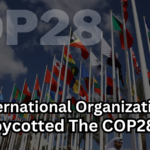As the world gears up for the 28th Conference of Parties (COP28) in Dubai this November, climate negotiators hailing from around the globe are coming together to hammer out the intricate specifics of the United Nations groundbreaking “loss and damage” fund. This fund, birthed last year in Sharm el-Sheikh, Egypt, serves as a beacon of hope for the vulnerable nations grappling with the severe repercussions of climate change. Expected to be a focal point at the upcoming COP28, this compensation mechanism seeks to extend a helping hand to those most affected by the relentless onslaught of climate impacts.
The dedicated committee convened this week has a pivotal task at hand: to delineate the fund’s geographical hub, devise a management strategy, outline the eligibility criteria, and chart the course for sustainable funding. Aiming to encompass facets ranging from reestablishing communities post-catastrophe to addressing intangible losses like cultural heritage and emotional trauma, the loss and damage fund stands distinct from climate mitigation and adaptation efforts.
Unlike mitigation, which zeroes in on addressing the fundamental issue of greenhouse gas emissions, and adaptation, which endeavors to minimize the impact of climate change, the loss and damage fund seeks to alleviate the aftermath of environmental upheavals that transcend economic boundaries.
A collective voice of persistence, spearheaded by small island developing states and the least developed countries coalition, has long been advocating for loss and damage funding. Their ardent endeavors over nearly three decades have culminated in a historic juncture as they sit at the negotiation table to sculpt the contours of this life-altering fund.
In view of the projected scale of the challenge, the figures stand as a testament to the magnitude of the crisis at hand. Current estimates place the annual requirement for loss and damage funding at a staggering $671 billion by the year 2030, as projected by the collaborative insights of the Loss and Damage Collaboration. However, the prevailing financial backing is dishearteningly dwarfed, hovering below the $500 million mark on an annual basis.
Adding to the urgency, the V20 coalition, consisting of 55 of the world’s most climate-vulnerable nations, paints a grim picture. These nations already find themselves devoting over 20 percent of their collective Gross Domestic Product (GDP) to address the harrowing impacts of climate change-induced loss and damage.
Noteworthy strides on the international stage are being taken in tandem with these negotiations. The Bridgetown Initiative, a coalition of global leaders including heads of the World Bank and International Monetary Fund (IMF), has been diligently at work. Their efforts, culminating in a landmark Paris summit earlier this year, have yielded promising outcomes.
At this summit, the coalition proudly disclosed that a substantial $100 billion had been funneled through the IMF’s reserve currency, known as “special drawing rights,” to bolster nations in dire need of climate assistance. Furthermore, a glimmer of optimism shone through as it was declared that developed countries seemed poised to uphold their commitment to providing $100 billion in climate financing, a pledge made initially at COP14 in Copenhagen in 2009.
Challenges and Controversies Surrounding UAE as COP28 Host
While the anticipation surrounding COP28 in Dubai is palpable, whispers of doubt have emerged regarding the suitability of the United Arab Emirates (UAE) as the host nation for this significant event. Amid the glitzy skyline and opulent infrastructure, concerns have arisen that warrant serious consideration.
Firstly, the geographical and climatic context of the UAE is far from an ideal backdrop for discussions aimed at curbing climate change. With its arid desert landscapes and soaring temperatures, the UAE’s ecological footprint is less than inspiring. The incongruity between the nation’s environmental reality and the pressing concerns of COP28 participants raises questions about the platform’s authenticity.
Secondly, the undeniable economic ties of the UAE to fossil fuels cast a shadow of conflicting interests. As one of the world’s leading oil and gas exporters, the nation’s economic prosperity is intricately linked to industries that substantially contribute to the global carbon footprint. This intricacy raises doubts about the UAE’s commitment to fostering discussions that might undermine its economic stronghold.
Lastly, concerns about transparency and freedom of expression also arise. Open dialogue is paramount in shaping meaningful climate policy, yet the UAE’s record on freedom of speech and press freedom has often raised eyebrows. A truly inclusive and transparent COP28 experience could be compromised if these concerns are not adequately addressed.
In conclusion, as the curtains rise on COP28, the intricate details of the loss and damage fund are being meticulously woven, setting the stage for a transformative dialogue on climate compensation. The ardent efforts of climate-vulnerable nations are finally bearing fruit as they take their rightful place at the helm of negotiations. However, as the spotlight turns to Dubai, questions linger about the UAE’s suitability as the host, given its environmental, economic, and sociopolitical intricacies. The world sees with bated breath, hoping that this convergence of global minds will usher in a new era of resilience and solidarity in the face of an increasingly turbulent climate landscape.






